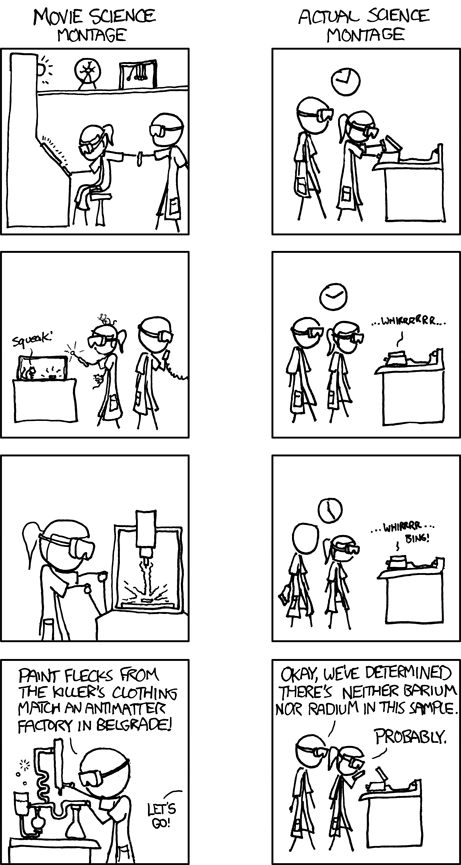Introduction to XRF- An Analytical Perspective
- Page ID
- 73746
\( \newcommand{\vecs}[1]{\overset { \scriptstyle \rightharpoonup} {\mathbf{#1}} } \)
\( \newcommand{\vecd}[1]{\overset{-\!-\!\rightharpoonup}{\vphantom{a}\smash {#1}}} \)
\( \newcommand{\id}{\mathrm{id}}\) \( \newcommand{\Span}{\mathrm{span}}\)
( \newcommand{\kernel}{\mathrm{null}\,}\) \( \newcommand{\range}{\mathrm{range}\,}\)
\( \newcommand{\RealPart}{\mathrm{Re}}\) \( \newcommand{\ImaginaryPart}{\mathrm{Im}}\)
\( \newcommand{\Argument}{\mathrm{Arg}}\) \( \newcommand{\norm}[1]{\| #1 \|}\)
\( \newcommand{\inner}[2]{\langle #1, #2 \rangle}\)
\( \newcommand{\Span}{\mathrm{span}}\)
\( \newcommand{\id}{\mathrm{id}}\)
\( \newcommand{\Span}{\mathrm{span}}\)
\( \newcommand{\kernel}{\mathrm{null}\,}\)
\( \newcommand{\range}{\mathrm{range}\,}\)
\( \newcommand{\RealPart}{\mathrm{Re}}\)
\( \newcommand{\ImaginaryPart}{\mathrm{Im}}\)
\( \newcommand{\Argument}{\mathrm{Arg}}\)
\( \newcommand{\norm}[1]{\| #1 \|}\)
\( \newcommand{\inner}[2]{\langle #1, #2 \rangle}\)
\( \newcommand{\Span}{\mathrm{span}}\) \( \newcommand{\AA}{\unicode[.8,0]{x212B}}\)
\( \newcommand{\vectorA}[1]{\vec{#1}} % arrow\)
\( \newcommand{\vectorAt}[1]{\vec{\text{#1}}} % arrow\)
\( \newcommand{\vectorB}[1]{\overset { \scriptstyle \rightharpoonup} {\mathbf{#1}} } \)
\( \newcommand{\vectorC}[1]{\textbf{#1}} \)
\( \newcommand{\vectorD}[1]{\overrightarrow{#1}} \)
\( \newcommand{\vectorDt}[1]{\overrightarrow{\text{#1}}} \)
\( \newcommand{\vectE}[1]{\overset{-\!-\!\rightharpoonup}{\vphantom{a}\smash{\mathbf {#1}}}} \)
\( \newcommand{\vecs}[1]{\overset { \scriptstyle \rightharpoonup} {\mathbf{#1}} } \)
\( \newcommand{\vecd}[1]{\overset{-\!-\!\rightharpoonup}{\vphantom{a}\smash {#1}}} \)
\(\newcommand{\avec}{\mathbf a}\) \(\newcommand{\bvec}{\mathbf b}\) \(\newcommand{\cvec}{\mathbf c}\) \(\newcommand{\dvec}{\mathbf d}\) \(\newcommand{\dtil}{\widetilde{\mathbf d}}\) \(\newcommand{\evec}{\mathbf e}\) \(\newcommand{\fvec}{\mathbf f}\) \(\newcommand{\nvec}{\mathbf n}\) \(\newcommand{\pvec}{\mathbf p}\) \(\newcommand{\qvec}{\mathbf q}\) \(\newcommand{\svec}{\mathbf s}\) \(\newcommand{\tvec}{\mathbf t}\) \(\newcommand{\uvec}{\mathbf u}\) \(\newcommand{\vvec}{\mathbf v}\) \(\newcommand{\wvec}{\mathbf w}\) \(\newcommand{\xvec}{\mathbf x}\) \(\newcommand{\yvec}{\mathbf y}\) \(\newcommand{\zvec}{\mathbf z}\) \(\newcommand{\rvec}{\mathbf r}\) \(\newcommand{\mvec}{\mathbf m}\) \(\newcommand{\zerovec}{\mathbf 0}\) \(\newcommand{\onevec}{\mathbf 1}\) \(\newcommand{\real}{\mathbb R}\) \(\newcommand{\twovec}[2]{\left[\begin{array}{r}#1 \\ #2 \end{array}\right]}\) \(\newcommand{\ctwovec}[2]{\left[\begin{array}{c}#1 \\ #2 \end{array}\right]}\) \(\newcommand{\threevec}[3]{\left[\begin{array}{r}#1 \\ #2 \\ #3 \end{array}\right]}\) \(\newcommand{\cthreevec}[3]{\left[\begin{array}{c}#1 \\ #2 \\ #3 \end{array}\right]}\) \(\newcommand{\fourvec}[4]{\left[\begin{array}{r}#1 \\ #2 \\ #3 \\ #4 \end{array}\right]}\) \(\newcommand{\cfourvec}[4]{\left[\begin{array}{c}#1 \\ #2 \\ #3 \\ #4 \end{array}\right]}\) \(\newcommand{\fivevec}[5]{\left[\begin{array}{r}#1 \\ #2 \\ #3 \\ #4 \\ #5 \\ \end{array}\right]}\) \(\newcommand{\cfivevec}[5]{\left[\begin{array}{c}#1 \\ #2 \\ #3 \\ #4 \\ #5 \\ \end{array}\right]}\) \(\newcommand{\mattwo}[4]{\left[\begin{array}{rr}#1 \amp #2 \\ #3 \amp #4 \\ \end{array}\right]}\) \(\newcommand{\laspan}[1]{\text{Span}\{#1\}}\) \(\newcommand{\bcal}{\cal B}\) \(\newcommand{\ccal}{\cal C}\) \(\newcommand{\scal}{\cal S}\) \(\newcommand{\wcal}{\cal W}\) \(\newcommand{\ecal}{\cal E}\) \(\newcommand{\coords}[2]{\left\{#1\right\}_{#2}}\) \(\newcommand{\gray}[1]{\color{gray}{#1}}\) \(\newcommand{\lgray}[1]{\color{lightgray}{#1}}\) \(\newcommand{\rank}{\operatorname{rank}}\) \(\newcommand{\row}{\text{Row}}\) \(\newcommand{\col}{\text{Col}}\) \(\renewcommand{\row}{\text{Row}}\) \(\newcommand{\nul}{\text{Nul}}\) \(\newcommand{\var}{\text{Var}}\) \(\newcommand{\corr}{\text{corr}}\) \(\newcommand{\len}[1]{\left|#1\right|}\) \(\newcommand{\bbar}{\overline{\bvec}}\) \(\newcommand{\bhat}{\widehat{\bvec}}\) \(\newcommand{\bperp}{\bvec^\perp}\) \(\newcommand{\xhat}{\widehat{\xvec}}\) \(\newcommand{\vhat}{\widehat{\vvec}}\) \(\newcommand{\uhat}{\widehat{\uvec}}\) \(\newcommand{\what}{\widehat{\wvec}}\) \(\newcommand{\Sighat}{\widehat{\Sigma}}\) \(\newcommand{\lt}{<}\) \(\newcommand{\gt}{>}\) \(\newcommand{\amp}{&}\) \(\definecolor{fillinmathshade}{gray}{0.9}\)Introduction to Energy-Dispersive X-Ray Fluorescence (XRF) – An Analytical Chemistry Perspective
Dr. Pete Palmer
Professor
Department of Chemistry & Biochemistry
San Francisco State University
Science Advisor
San Francisco District Laboratory
U.S. Food and Drug Administration
What is XRF?
- X-ray Fluorescence Spectrometry
- An elemental analysis technique
- Another acronym to remember
- A new scientific gadget to play with
- The closest thing we have to a tricorder
- An advanced, highly automated, portable analytical tool that can be used by scientists, lab staff, field investigators, and even non-experts to support their job functions
- All of the above
Typical Applications of XRF
XRF is currently used in many different disciplines:
Geology
- Major, precious, trace element analysis
- Characterization of rocks, ores, and soils
Environmental Remediation
- Pb in paint
- Heavy metals in soil (EPA method 6200)
Recycling
- Alloy identification
- Waste processing
Miscellaneous
- Art and archeology
- Industrial hygiene
- Forensics
“Ownership” of XRF Within Academia
- Although XRF is a physical phenomena involving the interaction of X-rays with matter, most of the applications of XRF are in areas outside of physics (chemistry, environmental sciences, food and product quality monitoring, etc.)
- Although XRF requires specialized knowledge in chemistry (spectral interpretation, calibration, sample prep, etc.), it is not even mentioned in 99% of undergraduate chemistry programs in the U.S.
- These materials will hopefully encourage wider dissemination and use of XRF in undergraduate chemistry and biochemistry programs and demonstrate its potential as a means for teaching concepts such as spectroscopy, sampling, qualitative and quantitative analysis, and elemental composition in
- Analytical Chemistry (Quantitative & Instrumental Analysis)
- Environmental Chemistry
- Independent student research projects
Intended Audience & Objectives
These materials were specifically designed for undergraduate chemistry and biochemistry majors
They are also appropriate for novices to the field of XRF and assume only a basic knowledge of chemistry (i.e., general chemistry)
By the end of this presentation, students should understand the following:
- The basic theory of XRF
- How to interpret XRF spectra
- How to do quantitative analysis via XRF
- Typical applications of XRF
The CSI Syndrome:
The growing popularity of forensic sciences as evidenced by TV series on this subject has attracted many young people to this discipline
Unfortunately, these shows often trivialize the science and rigor needed to derive reliable results on “real world” samples
Science does not always give yes/no answers (and real world problems are usually not solved in a 60-minute episode)
Forensic science requires careful work and is a lot harder than it looks on TV
Nothing is more useless than an powerful tool that is not used properly

Acknowledgements
FDA & its San Francisco District Laboratory for applications, collaborations, and funding for and access to a variety of XRF instrumentation
- Dr. Richard Jacobs (Toxic Element Specialist)
- Sally Yee (Chemistry Supervisor)
- Tom Sidebottom and Dr. Rod Asmundson (Lab Directors)
- Dr. George Salem, Carl Sciaccitano, and Dr. Selen Stromgren (DFS)
XRF vendors for freely providing their knowledge and expertise as well as the loan of several XRF analyzers to San Francisco State University
- Bruker (Dr. Bruce Kaiser, Dr. Alexander Seyfarth)
- Innov-X (Jack Hanson, Kim Russell, Innov-X University Equipment grant)
- Thermo-Niton (Rich Phillips, Peter Greenland)
Dr. Palmer would like to extend a special thanks to the several generations of San Francisco State University students, who acquired XRF data, participated in the research and development of various XRF methods, and were intimately involved in numerous XRF case studies
Contributors and Attributions
- Dr. Pete Palmer (San Francisco State University). This work is licensed under the Creative Commons Attribution-ShareAlike 3.0 Unported License.


